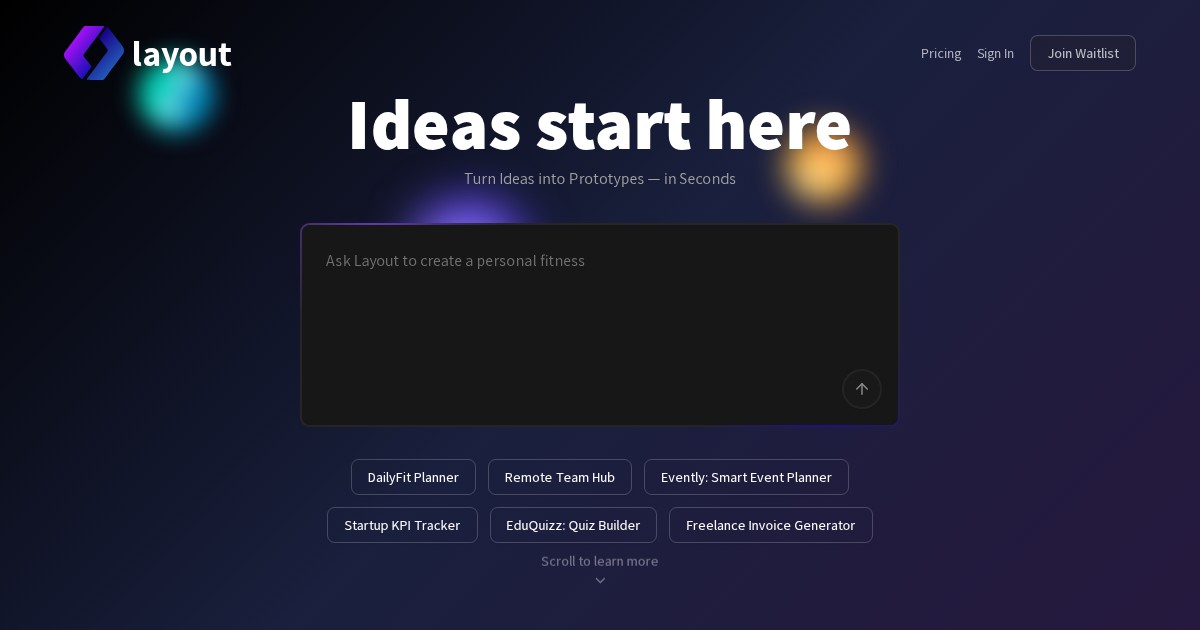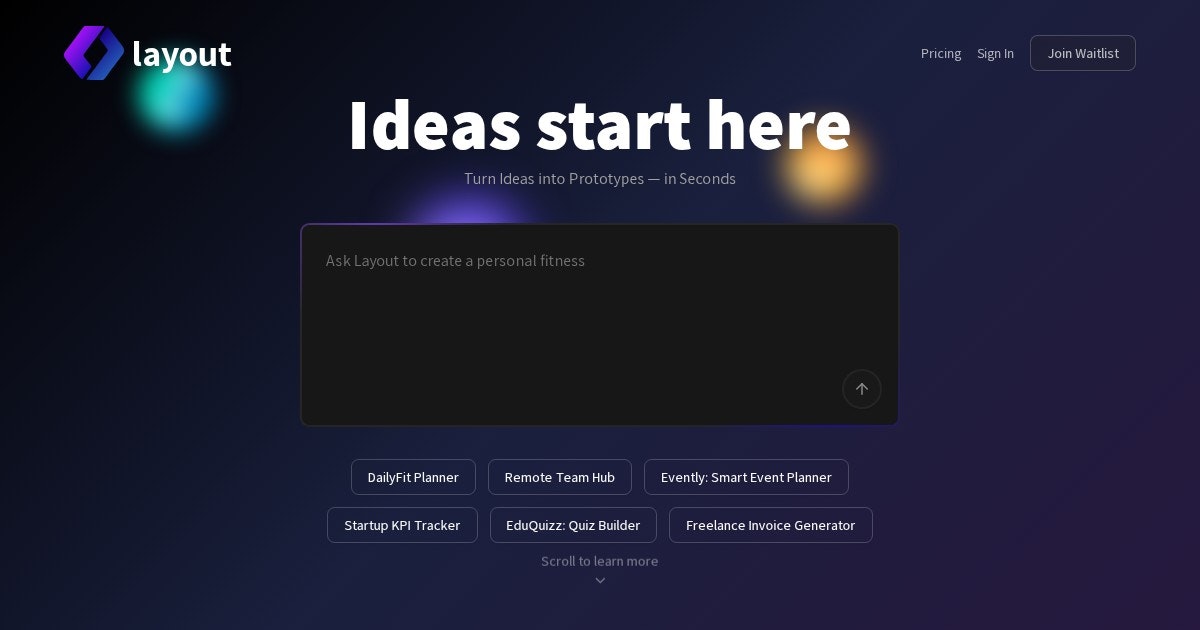
Table of Contents
Overview
Ever wished you could conjure a working software prototype from a mere idea? Layout.dev aims to make that a reality through cutting-edge artificial intelligence technology. This AI-powered platform is specifically designed for founders, developers, and entrepreneurs who want to transform their concepts into functional software prototypes with unprecedented speed and precision. By simply describing your vision in natural language, Layout generates clean, production-ready code, comprehensive UI components, and complete project structures, significantly accelerating your development workflow and reducing the traditional barriers between ideation and implementation.Built with modern web technologies and powered by advanced language models, Layout.dev bridges the gap between technical and non-technical users by democratizing software development. The platform emphasizes rapid prototyping while maintaining code quality, enabling users to iterate quickly on ideas, validate concepts with stakeholders, and build functional demonstrations without extensive programming knowledge.
Key Features
Layout isn’t just a simple code generator; it comes packed with powerful features designed to streamline your entire development process and deliver enterprise-grade results:- AI-generated full-stack applications: Generate complete applications including both frontend interfaces and backend functionality, database schemas, and API endpoints, providing a comprehensive foundation for web applications, admin dashboards, SaaS tools, and internal business systems.
- Instant project scaffolding with modern tech stack: Quickly build foundational structures using contemporary technologies including React for frontend development, TailwindCSS for responsive styling, and integrated database solutions, ensuring your projects start with industry-standard architectures.
- Natural language to code transformation: Leverage advanced AI models to convert plain English descriptions into functional, well-structured code that follows best practices, enabling rapid development without requiring deep technical expertise or complex syntax knowledge.
- Component-based architecture and design system: Build applications using modular, reusable components that promote scalability, maintainability, and consistency across your project, with automated generation of design system elements and component libraries.
- Real-time preview and iteration capabilities: Visualize your application as it develops with live preview functionality, allowing immediate feedback and rapid iteration cycles that accelerate the development process and improve design decisions.
- Export-ready production code: Download clean, well-documented, deployable code that integrates seamlessly with existing development workflows, supports version control systems, and can be deployed to popular hosting platforms like Vercel, Netlify, or AWS.
How It Works
The sophisticated process behind Layout.dev transforms abstract ideas into concrete, functional applications through a carefully orchestrated series of AI-powered steps designed for both simplicity and technical excellence.Users begin by describing their application concept in natural, conversational language through Layout’s intuitive interface. This could range from simple requests like “create a task management app” to complex specifications involving multiple features, user roles, and integration requirements. Layout.dev then employs state-of-the-art Large Language Models that have been specifically trained and optimized for code generation and software architecture patterns.
The AI system analyzes your description and begins constructing the entire application architecture, starting with database schema design, API endpoint planning, and frontend component structure. As the generation process unfolds, Layout creates not just static code but functional, interactive applications with proper state management, responsive design, and modern user interface patterns.
Throughout the development process, users can continuously refine their requirements through additional prompts, request specific modifications, and preview the generated application in real-time. The platform’s intelligent understanding allows for iterative improvements, feature additions, and design adjustments without starting from scratch. Finally, users can export the complete, production-ready codebase with comprehensive documentation, deployment instructions, and integration guidelines for seamless transition to production environments.
Use Cases
Layout.dev’s versatility and comprehensive feature set make it valuable across numerous scenarios and user types, addressing diverse development needs with consistent excellence:- Startup MVP development and validation: Rapidly build and test Minimum Viable Products to validate business concepts, gather user feedback, and demonstrate functionality to investors or stakeholders without extensive development costs or time investment.
- Developer prototyping and client presentations: Create functional demonstrations and proof-of-concepts that showcase proposed solutions, communicate technical approaches to non-technical stakeholders, and validate architectural decisions before committing to full-scale development.
- Product manager workflow design and testing: Design, prototype, and test new features, user flows, and system interactions to better understand user experience requirements, identify potential issues, and optimize product development strategies.
- Entrepreneur and solopreneur product launches: Accelerate the initial development phase for individual founders and small teams, enabling rapid market entry, iterative product development, and resource-efficient scaling of business operations.
- Educational technology and learning platforms: Create interactive demonstrations, teaching tools, and educational applications that help students, educators, and professionals understand software development concepts and modern web technologies.
Pros \& Cons
Like any sophisticated development tool, Layout.dev offers substantial advantages while also presenting certain considerations that users should understand:Advantages
- Significant development time savings and efficiency: Dramatically reduces the time required for initial application development, prototype creation, and proof-of-concept building, allowing developers and entrepreneurs to focus on business logic, user experience, and market validation rather than boilerplate code creation.
- Production-quality code output with modern standards: Generates clean, well-structured, and maintainable code that follows contemporary best practices, includes proper documentation, and integrates seamlessly with modern development workflows and deployment pipelines.
- Accessibility for non-technical users: Features an intuitive natural language interface that makes software development accessible to entrepreneurs, product managers, and business professionals without extensive programming backgrounds, democratizing the development process.
- Flexible pricing with free tier access: Offers a free plan with 30 monthly credits for experimentation and learning, alongside affordable pro plans that scale with usage, making it accessible for individual developers, startups, and established businesses.
Disadvantages
- Platform maturity and evolving feature set: As a relatively new platform, Layout.dev continues developing advanced features and may require ongoing refinement based on user feedback and technological improvements, though this also means rapid innovation and feature additions.
- Customization requirements for complex applications: Generated code may need manual refinement and customization for highly specialized business logic, complex integrations, or unique architectural requirements that exceed the platform’s current AI capabilities.
- Learning curve for optimization and deployment: While accessible to beginners, maximizing Layout.dev’s potential and successfully deploying generated applications may require some technical knowledge about modern web development practices, hosting platforms, and deployment procedures.
How Does It Compare?
When evaluated against the competitive landscape of AI-powered development tools in 2025, Layout.dev establishes a distinctive position through its comprehensive full-stack approach and emphasis on complete application generation.Vercel v0 (2025): Vercel’s v0 has evolved significantly, now offering comprehensive UI generation with their composite model family (v0-1.5-md and v0-1.5-lg) and seamless integration with the Vercel ecosystem. V0 excels in React component generation and provides excellent deployment integration with automatic responsiveness and modern styling through Tailwind CSS. However, v0 primarily focuses on frontend UI generation rather than full-stack applications. Layout.dev differentiates itself by providing complete application scaffolding including backend functionality, database design, and full project structure, making it more suitable for users seeking comprehensive prototype development rather than component-level UI generation.
Builder.io Visual Copilot 2.0 (2025): Builder.io’s Visual Copilot has advanced significantly with their 2.0 release, offering sophisticated Figma-to-code conversion with support for React, Vue, Angular, and other frameworks. Visual Copilot excels in design-to-code workflows with pixel-perfect accuracy and automatic responsiveness. The platform now includes AI-powered interactivity features and real-time design sync capabilities. While Builder.io provides excellent design translation capabilities, Layout.dev focuses on natural language to complete application generation, serving users who start with concepts rather than existing designs and need full-stack functionality rather than design implementation.
Replit Ghostwriter (2025): Replit Ghostwriter has matured into a comprehensive AI coding assistant integrated within Replit’s cloud-based IDE, offering code completion, explanation, transformation, and generation features. Ghostwriter excels in educational contexts and provides excellent real-time coding assistance within the Replit environment. However, Ghostwriter functions primarily as a coding assistant that helps write code within an existing development environment, while Layout.dev serves as a complete application generator that produces ready-to-deploy projects from high-level descriptions.
Modern AI Code Generation Platforms (2025): The 2025 landscape includes numerous specialized tools like GitHub Copilot for code completion, CodeParrot AI for component-based development, and various design-to-code solutions like Locofy and AnimaApp. These tools often excel in specific niches – Copilot in IDE integration, design-to-code tools in visual translation workflows, and specialized platforms in particular frameworks or use cases. Layout.dev’s strength lies in its end-to-end application generation approach that produces complete, functional prototypes from natural language descriptions, serving users who need rapid full-stack development rather than assistance with specific coding tasks.
Enterprise and Team-Focused Solutions: Platforms like Canva Code and other enterprise-focused AI development tools provide sophisticated features for large organizations with established development workflows. Layout.dev positions itself as an accessible solution for individual developers, startups, and small teams who need rapid prototyping capabilities without the complexity and cost structure of enterprise-focused platforms.
Final Thoughts
Layout.dev represents a compelling evolution in AI-assisted software development that successfully addresses the growing need for rapid prototyping and accessible application development. By combining advanced artificial intelligence with modern web development best practices, the platform democratizes software creation while maintaining the quality and standards expected in professional development environments.The platform’s strength lies in its ability to transform abstract ideas into concrete, functional applications through natural language interaction, eliminating many traditional barriers between concept and implementation. For entrepreneurs, product managers, and developers seeking to validate ideas quickly, Layout.dev provides an invaluable tool that accelerates the journey from ideation to working prototype.
While the platform continues evolving and may require some technical knowledge for optimal utilization, its commitment to accessibility and quality positions it as a valuable asset for the modern development landscape. The free tier allows experimentation and learning, while the pro plans provide the usage levels necessary for serious development work.
As the AI development tool ecosystem continues expanding, Layout.dev’s focus on complete application generation rather than specific coding tasks creates a unique niche that serves the growing demand for rapid, accessible software development. For users seeking to bridge the gap between ideas and functional software, Layout.dev offers a compelling solution that balances simplicity with capability, making it an essential tool for anyone serious about transforming concepts into working applications efficiently and effectively.
The platform’s roadmap suggests continued innovation in areas like team collaboration, enhanced backend capabilities, and expanded framework support, positioning it well for long-term success in the competitive AI development tool market.

